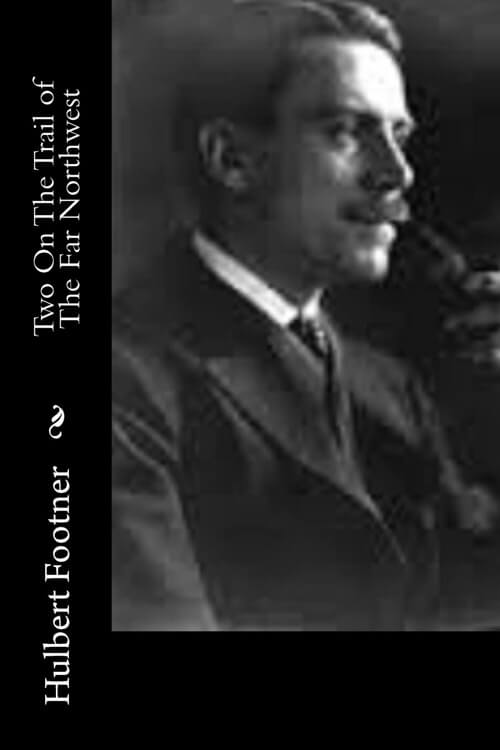
Two on the Trail, A Story of the Far Northwest
The interior of Papps’s, like most Western restaurants, was divided into a double row of little cabins with a passage between, each cabin having a swing door. Garth Pevensey found the place very full; and he was ushered into a cubby-hole which already contained two diners, a man and a woman nearing the end of their meal. They appeared to be incoming settlers of the better class—a farmer and his wife from across the line. Far from resenting Garth’s intrusion, they visibly welcomed it; after all, there was something uncomfortably suggestive of a cell in those narrow cabins to which the light of day never penetrated.
Garth passed behind the farmer’s chair and seated himself next to the wall. He had no sooner ordered his luncheon than the door was again opened, and the rotund Mr. Papps, with profuse apologies, introduced a fourth to their table. The vacant place, it appeared, was the very last remaining in his establishment.
The newcomer was a girl; young, slender, and decidedly pretty: such was Garth’s first impression. She came in without hesitation and took the place opposite Garth with that serenely oblivious air so characteristic of the highly civilized young lady. Very trimly and quietly dressed, sufficiently well-bred to accept the situation as a matter of course. Thus Garth’s further impressions. “What a girl to be meeting up in this corner of the world, and how I should like to know her!” he added in his mind. The maiden’s bland aloofness was discouraging to this hope; nevertheless, his heart worked in an extra beat or two, as he considered the added relish his luncheon would have, garnished by occasional glances at such a delightful vis-à-vis. Meanwhile, he was careful to take his cue from her; his face, likewise, expressed a blank.
The farmer and his wife became very uncomfortable. Simple souls, they could not understand how a personable youth and a charming girl should sit opposite each other with such wooden faces. Their feeling was that at quarters so close extra sociability was demanded, and the utter lack of it caused them to move uneasily in their chairs, and gently perspire.
Read or download Book
Hulbert Footner
Hulbert Footner (April 2, 1879 – November 17, 1944) was a Canadian-born American writer of primarily detective fiction. He also wrote some non-fiction.
Early career
He was born William Hulbert Footner in Hamilton, Ontario on April 2, 1879. His mother lived in New York City and was visiting with her parents in Hamilton, Ontario. Frances Christina Mills and Harold John Footner were his parents. Her family were loyalists who fled the United States between 1775 and 1815 and considered themselves British loyalists rather than either citizens of the United States or Canada throughout the 19th Century. His grandfather, William Footner, was born in England emigrated to Canada, settled in Montreal, and had a career in architecture; one of his surviving structures is Bonsecours Market, built in 1845.
Footner attended grade school in Manhattan and beyond that was self-educated. His complete reading program of classics of literature is laid out in his journal. His first known published item is a poem titled Roundelay For March published in 1902. His first article was published in 1903. Its subject was a canoe trip with a companion on the Hudson River, which began on the Fourth of July from the outskirts of New York City and ended in Montreal, Quebec, Canada.
Footner wrote a four-act play, titled, The Saving of Zavia in 1904 that he later retitled, “The Younger Mrs. Favor,” He accepted a part in a play, Sherlock Holmes, which opened in Baltimore when the lead actor committed to produce his play. His acting role took him to forty-one states and four Canadian provinces. His play was never produced. While traveling he wrote a vaudeville sketch for two characters, his Long-lost Child, which he and a comedian from the closed show performed in, until his partner asked that he replace himself. Two decades later a Baltimore Sun columnist wrote extensively about his early experiences in the theater world. He returned to New York and nearly starved there, living on thirty cents a day, but fully occupied by a long list of classic literary books and plays, which substituted for a formal education.
He accepted a reporter job on the Calgary “Morning Albertan” in 1906, which was the year after Alberta became a province. His job was dangerous in the lawless town. He was saved by an assignment that sent him to Edmonton to report on the first meeting of the new province’s legislature. He was appointed historian to a legislative expedition formed to explore the unexplored northern part of the province. His job was canceled when the expedition was abandoned and in his words, “I undertook to make the journey of 3000 miles or so on my own.” He traveled by canoe alone to Lesser Slave Lake, then to Peace River Crossing, and on to Spirit River and Pouce Coupe Prairie. He paid his expenses by syndicating the story to several Canadian newspapers.
He returned to New York City and took and lost an office job; almost starved again but sold two western adventure stories to Century magazine, after which he departed New York in his canoe for Chesapeake Bay in 1910. He experienced bad weather in Baltimore that forced him to take the steamboat Westmoreland with a ticket to Solomons, Maryland, a stop, according to the boat’s purser, that had not been made for seventeen years. He wrote Two on the Trail, his first novel at Solomons, which was published by Doubleday, Page & Co., in 1911. His story is a fictionalized version of his 1906, 3,000-mile canoe trip made through Northern Alberta alone. His story in this romantic and exciting, adventurous novel, retraces his voyage using a “scene by scene reproduction of the author’s single-handed experiences” in his canoe; “that is, his visual experiences, not his emotional ones, for he went alone!”
He made a second journey to the Northwest Territory, and this time with a partner, Auville Eager who he trained in canoe handling during a journey to Florida and return. His trip to the far north, unexplored regions of Canada began in the early summer of 1911. His explorations opened with a series of rickety, railroad rides west through the Rockies, north by wagons into British Columbia to Yellowhead Lake where they launched a ribbed, folding canvas boat and headed north down the Fraser River, and as he admits, “thoroughly scared of the rapids ahead”. He and his partner continued on a northerly course to the upper regions of Alberta on the great Hay River that flowed due north to the Great Slave Lake located in the Territory of MacKenzie. His explorations ended at the Alexandra Falls.
He and his partner took its rapids, portaged around the worst and hitched rides around others, paddled on its beautiful swift lakes, and thereby handled the dangerous rapids of Fraser River, and survived the dire predictions of everybody passed en route. He continued north to the Crooked River, then on to the Parsnip, the Finlay, and their dangerous rapids; east again through a mountain gap, down the mighty rapids of Peace River to Hudson Hope; that was followed by a six hundred mile paddle on Peace River to Fort Vermilion. There was a portage by horses to the Hay River and another paddle of several hundred miles that ended at Alexandra Falls, a 100-foot wall of water on August 29, 1911.






